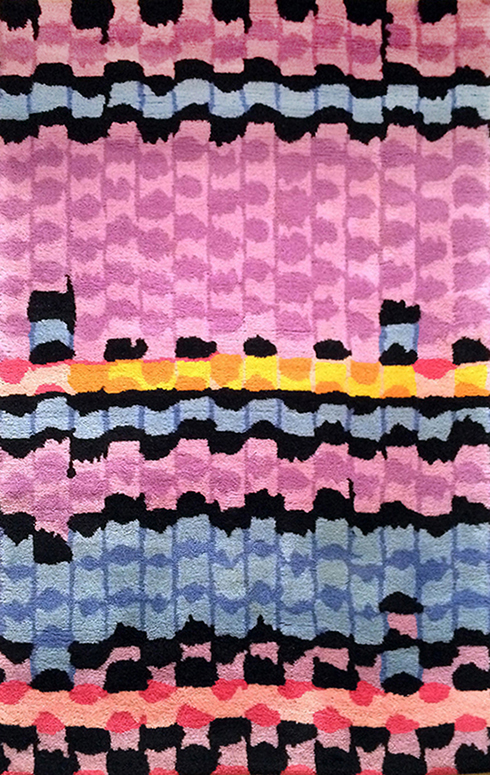
The Blog |

|
All Through the Industrial Revolutions: A Computer-Designed Tapestry
Heike Werner
|
|
Visitors of the 1968 Cybernetic Serendipity exhibition could easily walk over a slide projection of a »matrix multiplication« work by Frieder Nake on the entrance floor (1). Maybe this artwork flooring sparked the idea for the carpets Frieder Nake designed some years later. Around 1974, a limited series of tapestries with a computer-generated matrix pattern were produced by a German carpet company. The designs were based on computer graphics generated with the program »Matrizenmultiplikation« Nake had developed in 1967 (2). Over the last centuries, the history of textile and carpet art was closely connected to the history of »machines,« the weaving looms. In the late 18th century inventions like the power loom (1786) and a few decades later the Jacquard loom (1804) fueled the Industrial Revolution. The Jacquard loom, which had a punch card controlled Jacquard machine attached to a weaving loom, inspired the »father of computers« Charles Babbage (1791–1871) who adopted the punch cards in a case of technology transfer in the mid-1830s to control his mechanical calculator, the Analytical Engine. And just to do some counting of revolutions and ages: This Industrial Revolution turned out to be the First Industrial Revolution and it is seen as the dawn of the Machine Age – which peaked in the Second Industrial Revolution between 1870 and 1914 – and is today known as only the first of the Machine Ages. Because meanwhile, and this is the era we are in right now, the Second Machine Age started with the Digital Revolution, which is also known as the Third Industrial Revolution ... well, this counting sure goes on. (There is a link list below, history of technology is interesting stuff, check it out!) The Digital Revolution brought about even more technical developments to textile production and carpet art: In this era, the digital machines are not only weaving – they are generating their own patterns.
In the timeline of the Industrial Revolutions Frieder Nake’s tapestries mark a certain moment which makes them very special artefacts: These artist tapestries with their computer-generated motifs belong to the earliest examples, if not to the first in the history of carpet art, with patterns not only woven but also created by digital machines (3). For the textile industry in general, Georg Nees had already done graphical research on textures for the textile production in Germany using computer-generated patterns, that was around 1970, but more on this later ... These works and Nake’s carpets are obvious proof that the history of textile production and computers are indeed interwoven.
Thoughts while sitting on a matrix carpet – a shorter version of this post was published before on July 05, 2020: www.heikewerner.com/nake_en.html Notes and links: (1) The presentation of the matrix multiplication works at the Cybernetic Serendipity exhibition is described at http://dada.compart-bremen.de/item/artwork/685, access August 4, 2021. (2) Frieder Nake: Zwischen probabilistischer Theorie & präzisem Vergnügen. Zur frühen Computerkunst in der BRD. In: Web, Film, Medien, Computer – Wirklichkeit und Visionen der Informationsgesellschaft neue Medien und Technologien der Informationsgesellschaft. Tagungsreihe Band 2010, 7.–9. Juli 2010, BBAW, Berlin-Brandenburgische Akademie der Wissenschaften, edited by Klaus Rebensburg, pp. 56-58 (3) You can see Frieder Nake happily sitting on another matrix carpet in this article by Weser-Kurier.
Some Wikipedia links with more details on the history of technology:
This blog contains thoughts, informal texts and pics on computer art and more. There is no comment function, just feel free to send an email with your comments. |

imprint / contact privacy |
